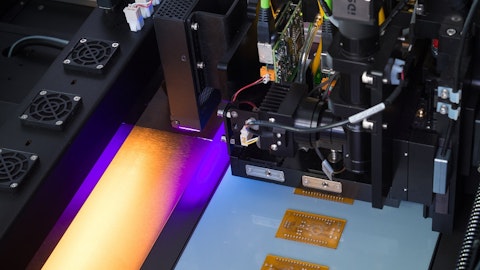So there’s a question of when you build France and Texas, how do you stagger them or are they going to be right on top of each other and how the CapEx for those two programs, net of incentives, sort of add together? And we believe we have a balance sheet and a cash flow in place to fund all that. So, we don’t have to take on debt to do it, just to answer that question. And how we’re going to – I mean, by just nature, I think as opposed to intention, these projects will end up staggered one way or another. It would be extremely unusual if they both start at the same time just based on getting permits and contracts and everything else. So they’ll be staggered to some degree. That’s all factored into our analysis about how we work through ’25 and ’26.
I don’t know if you want to add to that, Willie.
William McLain: Yes. So what I would just say is we’re confident that we can keep a strong investment, great balance sheet through that. You’re seeing that as we updated our guidance on capital this year of being $700 million to $750 million and expecting share repurchases of $200 million to $300 million. And as Mark has outlined, we’ve always been agile between our growth investments and then using any excess cash for bolt-ons and then returning cash to shareholders. We will continue to be disciplined in that capital allocation, and we expect to generate the cash flow to fund our strategy.
Laurence Alexander: Thank you.
Operator: Our next question comes from Mike Sison of Wells Fargo. Please go ahead.
Mike Sison: Hi, guys. Nice start to the year. Mark, when you think about maybe a ’26, ’27 sort of longer-term earnings potential, your methanolysis facility in the U.S. is ramping up well, it sounds like. And if you add that the potential scale-up there plus potential volume, is there sort of a EBITDA potential you think you can get back to or get above? I think you peaked about 2.2 in ’21. Just framing up what the earnings potential is if volume does recover over the next several years?
Mark Costa: Yes, Mike. Let me start with – last year, we had $1.6 billion of EBITDA. This year, our guidance is $1.8 billion. And what I would say, as we’ve talked about normalized, that’s going to be north of 2 billion. As we think about adding $150 million to $200 million for the Kingsport plant, that puts us in that $2.4 billion range. And then there’s upside as we think about adding the Longview project in the France project on top of that. But we’re obviously highly focused right now on delivering the growth in Advanced Materials and Additives & Functional Products with the investments we’ve done to date.
William McLain: As Mark just highlighted from an end market, ultimately, we’re leveraged to a recovery in the economy now that destocking is substantially behind us and that’s what we’re focused on delivering.
Mark Costa: And if you do look at it on a historical comp basis, it’s more compelling because we saw that and sometime has EBITDA in adhesives and tires and use the proceeds of activity share count and you know basically neutralizing what we saw that EBITDA. So we get to EPS level that Willie just told you is much more significant on EPS and stock price basis.
Mike Sison: Great. Thank you.
Operator: Our next question comes from Arun Viswanathan of RBC. Please go ahead.
Arun Viswanathan: Great. Thanks for taking my question. I had a similar question to Mike here. So if you think about your bridge to EPS, it looks like you’re on a path to do about $3.60 or so in the first half. And that would imply about $4.00 to $4.40 for the second half depending on where you land in the range, the midpoint to the upper end. And so, that $4.00 to $4.40, maybe if you annualize that for next year, that’s $8.00 to $8.80, which would kind of fall in line with your maybe 10% EPS growth targets or 8% to 12%. Is that how you guys are thinking about how you kind of progress from here? And if that is the case, would that be mainly kind of volume recovery and maybe some methanolysis? Or how are we thinking you guys are feeling about kind of where you are in the evolution here with the return of some primary demand and some volume growth? Do you see that target of 8% to 12% EPS growth back in view? Thanks.
William McLain: Yes. I think you framed it well. And I think it fits into the end-market lens and the leverage to the volume growth that we’ve seen since 2019, which is – it’s basically been roughly flat to slightly negative since that timeline at the corporate level on the volume mix line. With the combination of Advanced Materials and the leverage, we talked about how that volume mix drops to the bottom line with the fixed cost structure that we’ve had in combination with the growth. In the back half of this year, we see that leverage for the application growth as well as the back half EBITDA growth for the methanolysis facility. When we look into growth in 2025, we’ve talked about another $75 million of EBITDA growth from methanolysis and the application wins that we’ll have there as well as we’re at solidifying our contract structure on fiber.
So you can consider that stable in this period. And we will have growth as ag recovers, as building and construction recovers and AFP. And I would say we’re at the sort of trough levels in the intermediate space. So 10% growth at the midpoint is reasonable as we go forward.
Mark Costa: I’d just say that AFP also has growth. We’re at an exceptionally low level of heat transfer fluid fills this year. We have a clear order book to that $30 million drop from ’23 to ’24 to recover that as we go into ’25, not to mention B&C having any kind of market recovery would be upside. So there’s upside in AFP. There’s a lot of upside in AM, stability in fibers, CI is at the bottom of the market. So at some point, start coming off of that and recovering from a spread point of view. So there’s multiple ways you sort of combine that together to get to growth next year versus this year.
Arun Viswanathan: Thanks.
Greg Riddle: Let’s make the next question the last one, please.
Operator: Thank you. So our final question comes from Salvator Tiano of Bank of America. Please go ahead.
Salvator Tiano: Thank you very much. So firstly, I wanted to ask a little bit about the France project. And setting aside CapEx and regulations, how do you see the OpEx there? And especially because I think a couple of months ago, you signed an agreement with a recycling company to import PET waste from as far away as Italy and Spain, which obviously it would mean pretty high [indiscernible] cost. So does this mean that there could be – that the France project may have elevated OpEx because of that? Firstly and secondly, why – so far, you haven’t signed agreements for more domestic supply because I would think that in Europe with our single-stream PET recycling, it would be the ideal location and yet you still have to go as far as France and Italy to get feedstock.
Mark Costa: So this is a large-scale project and aggregating feedstock from a wider range than just France, given the state of the current infrastructure in Europe for collection and sortation is the appropriate thing to do, right? So France is a huge opportunity to improve in collections and sortation. It’s part of why they want to really support this project. Currently, we have about 70% of our feedstock under contract, which is a mixture of France, Germany, at least Spain, as you noted. Logistics costs were always factored into our economics for this approach to the marketplace. So that’s all built in. But the last 3% is not signed because we want to work with the French government and the local municipalities across France to sort of get that feedstock closer in as they develop that infrastructure.
So that’s sort of where we want to go. That’s why we’re not signing up for any more from other places because we’re focusing on how to get more out of France for that last remainder. But that’s all built in. And the actual logistics cost per kg is not significant in the economics for this plan.
Salvator Tiano: Okay, perfect. Then the other thing I want to clarify is about what do you expect for this year fibers volumes because Q1 was down 7% sequentially. You talk about Q2 being similar to Q1 and then another step-down in second half. So that pretty much seems to imply a very big annual decline, which I don’t think is what we were expecting.
William McLain: On the volume, what I would say is, there is only – we’ve talked about Naia growing. And we expect that to grow on the – at the date front, we would expect, I’ll call it, flat to modestly down, but we also provide intermediates and flake. And we would expect that’s where some of the volume would be declined.
Mark Costa: Yes. On a full year basis, it gets a little complicated when you’re doing – looking at sequential and year-over-year numbers for this. The total volume is relatively flat to last year when you look at it on a full year basis.
Salvator Tiano: Okay, perfect. Thank you very much.
Greg Riddle: Okay. Thank you everyone for joining us today. I really hope you have a great day and a great weekend. Thank you.
Operator: This concludes today’s call. Thank you for your participation. You may now disconnect.
Follow Eastman Chemical Co (NYSE:EMN)
Follow Eastman Chemical Co (NYSE:EMN)
Receive real-time insider trading and news alerts




